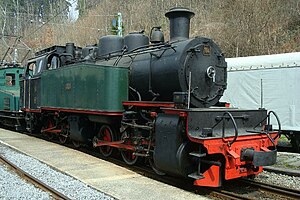SEG 104
| SEG 104 | |
|---|---|
|
SEG 104 Blonay – Chamby museum railway
|
|
| Numbering: |
SEG 104 MEG 104; Albtalbahn 12s, Brohltalbahn II |
| Number: | 2 |
| Manufacturer: | Hanomag |
| Year of construction (s): | 1925, 1928 |
| Type : | C'C n4vt |
| Genre : | K 66.9 |
| Gauge : | 1000 mm ( meter gauge ) |
| Length over buffers: | 11,400 mm |
| Total wheelbase: | 7,000 mm |
| Empty mass: | 45,000 kg |
| Service mass: | 56,500 kg |
| Wheel set mass : | 9.0 t |
| Top speed: | 35 km / h |
| Coupling wheel diameter: | 900 mm |
| Driving wheel diameter: | 900 mm |
| Control type : | Heusinger |
| Number of cylinders: | 4th |
| HD cylinder diameter: | 400 mm |
| LP cylinder diameter: | 620 mm |
| Piston stroke: | 450 mm |
| Boiler overpressure: | 14 bar |
| Grate area: | 1.85 m² |
| Tubular heating surface: | 7.38 m² |
| Evaporation heating surface: | 73.8 m² |
| Water supply: | 6 m³ |
| Fuel supply: | 1.5 t |
| Brake: | Suction air brake |
| Coupling type: | Balance lever coupling |
The SEG 104 is a six-axle Mallet locomotive for 1000 mm gauge . It ran from 1925 to 1967 on the Zell – Todtnau railway line and is now (2019) on the Blonay – Chamby museum railway . The locomotive is nicknamed Zell .
history
When rolling carriage traffic to Todtnau was to be introduced on the meter- gauge narrow - gauge railway from Zell – Todtnau , a powerful locomotive was required. The Bavarian Gts 2 × 3/3 from 1917 was used as the basis.
The new locomotive was built as a replica by Hanomag in 1925 under the factory number 10437. This powerful locomotive was able to handle roll-head traffic on the steep, steep narrow-gauge railway in Baden. In the period before World War II , manufacturing and mining companies had to be supplied. The peak value of the goods to be transported was 40,178 tons in 1938.
This value was never reached again after the war. Over the years, the question of economic efficiency for the locomotive arose. Nevertheless, the steam locomotives were in use until the end of operation on the narrow-gauge railway, even if they were no longer used regularly in the 1960s. A replacement by diesel locomotives was not considered, since with the output of 585 PS of the SEG 104, dieselization would not have resulted in an increase in output. In 1966, freight traffic was so low that a railcar could take care of it.
The Mallet locomotive had become so popular in operation that it was sold to the Blonay – Chamby heritage railway when it ceased operations in 1967. It was no longer in use there from the turn of the millennium. In 2018, a project to rebuild the narrow-gauge locomotive in working order began.
Albtalbahn 12s
A largely identical locomotive was manufactured in 1928 under the factory number 10570 for the Albtalbahn , it was used as a 12s. However, with an axle load of 9 t it was too heavy for the routes there and was rarely used. In 1934 it was sold to the Brohltalbahn , which used it under No. II. Since it was suitable for steep routes, it contributed to giving up the laborious cogwheel operation. In 1957 it was retired and scrapped.
construction
Although the SEG 104 is a replica of the Bavarian Gts 2 × 3/3, there are some differences in the design. It was created as a wet steam locomotive and has different dimensions compared to the Henschel development . The water supplies have been increased to 6 m³ compared to the Bavarian narrow-gauge locomotive. There are slight differences in the weights and dimensions. The steam engine shows the same parameters except for the superheater .
Originally the locomotive was equipped with a suction air brake. The compressed air brake was only applied to the Blonay – Chamby museum railway.
literature
- Gerd Wolff, Hans-Dieter Menges: German small and private railways . tape 2 : bathing . EK-Verlag, Freiburg 1992, ISBN 3-88255-653-6 , p. 272 .
Web links
- Data sheet of the SEG 104 at the Blonay – Chamby museum railway
- Website on Hellertal start images via SEG 104
- Presentation of the SEG 104 locomotive with museum operation
Individual evidence
- ^ A b Gerd Wolff, Hans-Dieter Menges: German small and private railways . tape 2 : bathing . EK-Verlag, Freiburg 1992, ISBN 3-88255-653-6 , p. 263 .
- ↑ Data sheet for SEG 104 on fgb gallery
- ↑ Presentation of the SEG 104 for rebuilding the locomotive in running order
- ↑ Presentation of the SEG 104 at www.zimo.at/soundprojekte
